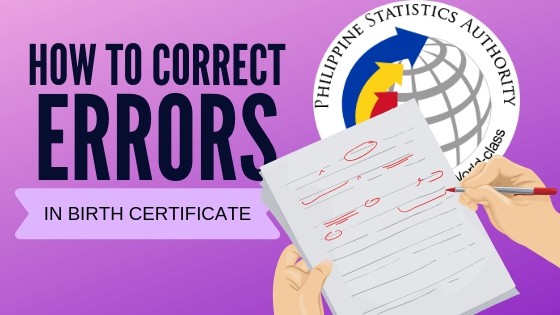How To Correct Errors in Birth Certificate: An Ultimate Guide for Filipinos

The importance of the birth certificate is unmatched by any other government-issued document.
Not only is it your primary proof of identity, but it’s also a critical requirement for Philippine passport application, school enrollment, job application, and virtually all important transactions you’ll ever make.
This is why it can be frustrating to go through the process of applying for a PSA birth certificate only to find out that your name is misspelled, your birth date is wrong, or some entries are blurred out, among other errors that may deem your birth certificate practically useless.
However, depending on the birth certificate correction you need, you can either wait for a court proceeding or process the correction yourself. This guide provides everything you need to know to correct errors in your birth certificate without all the legal mumbo jumbo.
READ: How to Get PSA Birth Certificate in the Philippines: An Ultimate Guide
How To Apply for Birth Certificate Correction in 4 Steps
1. Find Out Which Type of Birth Certificate Correction You Need

Birth certificate correction used to be complicated as it required a court order before any correction can be done. Fortunately, recent amendments have made it possible for applicants to process some of the corrections themselves without the need for a court proceeding.
To help you determine whether your case will involve the court or not, let’s dive into the two basic types of birth certificate correction:
a. Administrative correction
Birth records are copied, written, and transcribed by real humans, not robots. Hence, it’s not unusual for these people to commit clerical or typographical errors in the process of creating the birth certificates.
Examples include the wrong date of birth, gender, and spelling of the name. These mistakes are usually harmless and were made unintentionally (i.e., with no goal of forging the document).
Although birth certificates with these errors may cause delays in whatever it is you’re applying for, the silver lining is they’re relatively easier to fix.
Birth certificates with clerical or typographical errors can be corrected administratively (hence the name) which means you don’t need to go through a court proceeding for the correction to take place. Instead, you can file the petition to correct the error directly with the local civil registrar where the birth was reported.
The local civil registry office, in turn, will process the correction after evaluating the said petition.
There are four different types of birth certificate correction that fall under this category:
i. Change of First Name
- The first name being used is different from the first name on the birth certificate.
- The first name on the birth certificate is written as “Baby Boy,” “Baby Girl,” “Boy,” or “Girl” and the child was born 1993 onwards.
ii. Wrong Gender or Wrong Day or Month of Birth
- The date of birth (day or month) is wrong.
- The wrong gender is checked.
iii. Clerical Error Correction
- Blurred name (first, middle, or last name).
- The mother’s last name is wrong while the child’s middle name is correct.
- The child’s middle name is wrong while the mother’s last name is correct.
- Wrong spelling of the name (first, middle, or last name).
- Middle and last name have been interchanged.
- Middle initial entered instead of the full surname.
- The wrong gender is checked (Muntinlupa Civil Registrar).
iv. Supplemental Report
- No first name, middle name, or last name (if legitimate).
- No middle name (if illegitimate and acknowledged by the father).
- The first name on the birth certificate is written as “Baby Boy,” “Baby Girl,” “Boy,” or “Girl” and the child was born before 1993.
- Missing “Jr.” or any other name suffix.
- No checkmark for gender/there are checkmarks for both genders (Muntinlupa Civil Registrar).
- The illegitimate child wants to use the father’s surname. Take note that this correction only involves the surname. Changing status to legitimate requires court order/proceeding.
Aside from those mentioned above, administrative correction also applies to other encoding errors like two interchanged letters in the child’s name, a missing syllable in the last name, etc.
Again, you can only file a petition for correction with the local civil registrar for birth certificates with obvious clerical errors. If you’re unsure about which category your case falls under, you may reach out to the Philippine Statistics Authority via the following:
- Over the phone: Legal Department of the Philippine Statistics Authority at +632-938-5273.
- Snail mail addressed to Atty. Lourdines C. Dela Cruz, Director III, 4/F PSA-TAM Bldg., East Avenue, Quezon City, 1101.
b. Judicial correction
In cases when the birth certificate correction is so substantial that it has a profound bearing on your legal or inheritance rights, the court takes over.
For example, whereas correction for the wrong spelling of the name can be filed with the local civil registrar, the same process doesn’t apply to change of the applicant’s name or the parents’.
Substantial corrections will require you to file a petition for correction of entry with the Regional Trial Court (RTC) of the province where the local civil registrar holding your birth records is located.
In summary, the following cases require judicial proceedings for the correction to take place:
- Change in citizenship/nationality.
- Wrong year of birth/birth year.
- The middle names of the mother and child in the birth certificate are incorrect.
- Substantial changes to the parents’ (mother, father, or both) names.
- Changes that involve the child’s legitimacy/illegitimacy like whether the parents got married or not.
- Name change.
2. Prepare the Requirements for Birth Certificate Correction

Each type of correction demands a different set of requirements.
Assuming that you already learned from the previous section the specific correction you’ll be applying for, it’s now time to prepare the documents and fees you need for that particular correction.
a. Administrative correction
i. Change of First Name
For this type of correction, the applicant will need to file a petition for Change of First Name (according to Republic Act 9048 or the Clerical Error Law).
In case the name on your birth certificate is “Baby Boy, “Baby Girl,” “Boy,” or “Girl,” you can only file a petition of Change of First Name if your birth year is 1993 onwards. Applicants born in 1992 or earlier must file an application for a Supplemental Report instead (more on this later).
Among the four types of administrative correction, Change of First Name is the longest (up to 7 months) and most expensive to process.
The list below presents the core requirements you need to prepare for the Change of First Name. Remember, this correction is the most complex administrative correction so you’re expected to provide complete or as many supporting documents as possible (both original copies and photocopies).
- Petition for Change of Name (notarized) which you can obtain at the local civil registry office.
- PSA Birth Certificate containing the entry to be corrected.
- NBI clearance, police clearance, civil registry records of ascendants or any other clearances that the local civil registrar may request from the applicant.
- Any 2 valid public or private IDs/documents upon which the correction will be based: Certificate of Employment/Affidavit of Non-Employment, community tax certificate (cedula), baptismal certificate, school record Form 137/diplomas/transcripts, medical certificate, voter’s ID/certificate/affidavit, SSS ID, GSIS ID, driver’s license, PRC license, company ID, insurance, land title/certificate of transfer of title, bank records/passbook, marriage certificate, Philhealth ID, Pag-IBIG ID, etc. Again, provide as many proofs as possible and ensure the documents or IDs you’ll present show your correct first name.
- Fee: Filing fee of Php 3,000 (for local applicants) or $150 or the equivalent value in local currency (for those filing the petition abroad). In addition to this, expect to also pay a publication fee of anywhere between Php 1,200 and Php 2,500 as well as other notarization and requirement-related fees.
ii. Wrong Gender or Wrong Day or Month of Birth
If the wrong gender is checked on your birth certificate (e.g., Male is checked when you’re a female or vice versa), you need to file a petition under R.A. 10172.
On the other hand, if both genders are checked or no gender was chosen at all, you will need to file a Supplemental Report instead (more on this later).
All applicants who will request for their gender to be corrected will personally appear before a doctor accredited by the government. This doctor is usually assigned at the local civil registrar where you’ll file the petition.
The purpose of the medical examination is to ensure no sex transplant occurred prior to the request for birth certificate correction.
As for the wrong birth date, the administrative correction only applies to those with the wrong day or month of birth on their birth certificates. Correction of the wrong year of birth requires a court/judicial proceeding.
To file a petition to correct the wrong gender or wrong day/month of birth, bring the original and photocopies of the requirements listed below.
- Petition to correct the wrong gender or wrong day/month of birth (notarized). You can obtain this at the local civil registrar where your birth was registered.
- PSA Birth Certificate containing the entry to be corrected.
- NBI Clearance and Police/PNP Clearance.
- Certificate of Employment or Affidavit of Non-Employment.
- Elementary school records/documents. For applicants who never went to school, please submit an Affidavit attesting to the facts.
- Medical records from the hospital/clinic where the applicant was born. In case the records are no longer available because the hospital/clinic already closed down, submit an Affidavit attesting to the facts.
- Baptismal certificate or other documents issued by the church. In case no baptismal certificate or similar document can be obtained, submit an Affidavit attesting to the facts.
- PSA Marriage Certificate and Birth Certificate of children (for married applicants only).
- Any 2 valid public or private IDs/documents upon which the correction will be based: Income Tax Return, bank records, PRC license, Land Title or Certificate of Transfer of Title, driver’s license, company ID, voter’s ID, SSS, GSIS, Philhealth, Pag-ibig, etc.
- Medical Certification issued by the city/municipal doctor or health officer after evaluating the true gender of the document owner and ensuring that no sex change/transplant took place.
- Fee: Filing fee of Php 3,000 (for local applicants) or $150 or the equivalent value in local currency (for those filing the petition abroad). In addition to this, expect to also pay a publication fee of anywhere between Php 1,200 and Php 2,500 as well as other notarization and requirement-related fees.
iii. Clerical Error Correction
Blurred entries in the birth certificate don’t automatically qualify for administrative correction. If the PSA birth certificate is blurred but the LCR (local civil registrar) copy is not, you should file for endorsement so that the LCR can forward the document with clearer entry to the PSA.
However, if both the PSA and LCR copies are blurred, this is the time that you should file a petition for correction of a clerical error (under the provisions of R.A. 9048).
The following is a list of the basic requirements for the correction of clerical errors:
- PSA Birth Certificate containing the entry to be corrected.
- Any 2 public or private documents/IDs which will be used as the basis for the clerical error correction: NBI clearance, police clearance, land title or certificate of land transfer, insurance, driver’s license, civil registry records of ascendants, medical record, employment record, business record, voter’s affidavit, baptismal certificate, or GSIS/SSS record.
- Fee: Php 1,000 for the filing fee (for local applicants) or $50 or equivalent value in local currency (for applicants abroad). Notarization and other document processing fees may raise the total amount of fees to as high as Php 2,000.
- Other documents that may be requested by the local civil registrar.
iv. Supplemental Report
All birth certificate corrections that don’t qualify for the previous three categories of administrative correction usually require a supplemental report.
The most common error that needs a supplemental report is the absence of a name–first, middle, or last name–in the birth certificate. If any of these three names are blank, the document owner must file a supplemental report with the local civil registrar where the birth was reported so that the missing entry can be supplied.
A supplemental report can help supply these missing names, specifically the middle name, provided that the document owner is a legitimate child.
Illegitimate children who are acknowledged by their fathers can also file a supplemental report so they can use their mother’s last name as their middle name. On the other hand, illegitimate children who aren’t acknowledged by the father can let go of the middle name and simply bear their given names followed by their mother’s surname.
Among the four types of administrative correction, the supplemental report is cheapest, easiest, and the fastest to complete. In fact, you can make a maximum of 2 changes in your birth certificate through the supplemental report.
Here’s a rundown of the basic requirements you need to submit when filing a supplemental report:
- PSA Birth Certificate containing the entry to be corrected.
- An affidavit indicating the missing entry (for those with no first, middle, or last name) and the reason/s why the required entry wasn’t supplied.
- At least 2 to 3 valid public or private documents/IDs that show your correct personal information: GSIS/SSS record, medical record, voter’s affidavit, employment record, business record, school record, driver’s license, insurance, land titles or certificate of land transfer, civil registry records of ascendants, NBI clearance, or police clearance.
- Other documents that are relevant to your case that may be requested by the local civil registrar.
- Fee: Approximately Php 1,000 or less.
b. Judicial correction
Changes in the birth certificate that are substantial and therefore you can’t process on your own go through judicial proceedings.
Requirements for judicial correction are as follows:
- Documents containing information or entries pertinent to your case. The documentary requirements you’ll submit depends on the correction you’re requesting and will be subject to evaluation once you file your case with the Regional Trial Court (RTC). For example, if your request is to correct your father’s citizenship on your birth certificate, you must submit proof to support it like his passport and your sibling’s birth certificates.
- Fees: Prepare to pay court fees which is the sum total of the initial filing, sheriff’s, photocopying, postage, and notarization fees. You also need to ready your pocket for these additional fees: Newspaper fees for the mandatory three-week publication requirement; lawyer’s professional fees, the cost of which depends on how complicated your issue is; pleading fees and court appearance fees.
3. Proceed to the Appropriate Government Office To File Your Petition

a. Administrative correction
Compile the requirements and proceed to the local civil registrar where your birth was reported. This is usually located within or near the city/municipal hall.
No online appointment is needed but you need to personally appear before the local civil registrar when filing the petition. Most civil registrar offices in the country don’t accept Special Power of Attorney (SPA) if the owner of the birth certificate is not present.
Applicants who are minor or physically/mentally incapacitated likewise need to personally appear on the day of the filing but the petition can be filed by their spouse, any of the children, parents, brothers, sisters, grandparents, guardians, or authorized representatives.
In case you have already moved to another place and don’t have the time nor the money to personally file the petition at the civil registrar of the place of your birth, proceed to the nearest civil registrar.
Through the “migrant petition,” the civil registrar can still process your birth certificate correction even if it doesn’t have jurisdiction over the place of your birth.
The downside is migrant petition is relatively more expensive and takes longer to complete since your current civil registrar must coordinate with the civil registrar where your birth was originally recorded.
Those who are abroad, meanwhile, can file the petition at the Philippine Consulate or Embassy where the birth was reported.
Take note that if you’re filing two requests at the same time, you will only pay for the more expensive petition. For example, if you’re filing for the correction of a clerical error (Php 1,000) and at the same time requesting the change of first name (Php 3,000), you’ll only be charged Php 3,000 since the latter cost more.
The following is the summary of procedures you should expect to go through for each type of administrative correction:
i. Change of First Name
Head over to the local civil registrar and file a petition to change your first name. Submit the notarized copy along with the rest of the requirements.
Pay the appropriate fees and secure the notice of publication. Wait for 2 weeks or so for the documents to be posted and your petition to be published in the newspaper.
Get the proof of publication and endorsement from the local civil registrar and then forward them to the Office of the Civil Registrar General in Manila. Processing time takes 1 to 3 months but you’re welcome to follow up.
Once the petition is approved, you can then send it back to the local civil registrar for certification. This certified copy must then be forwarded to the PSA so they can prepare and issue your annotated birth certificate.
ii. Wrong Gender or Wrong Day or Month of Birth
The same process as Change of First Name (see the previous section).
iii. Clerical Error Correction
Proceed to the local civil registrar and have your case evaluated. Once they’ve ensured that you’re qualified for the correction of a clerical error, ask for the checklist of requirements as it may vary depending on your issue.
File the petition by submitting the form along with the other requirements during the interview with the local civil registrar.
Pay the fees, keep the receipt, and return to the office on the date indicated on the receipt to claim your approved petition.
Send this petition to the Office of the Civil Registrar General in Manila. Keep following up until they approve your petition.
Once approved, you’ll be notified by the local civil registrar that your Certificate of Finality is ready for pick up. Mail this certificate along with other relevant documents like the Endorsement letter, etc. to the Office of the Civil Registrar General in Manila.
Soon thereafter, you can finally receive your annotated birth certificate from the PSA.
iv. Supplemental Report
Go to the local civil registrar and have them evaluate your case. Once they’ve confirmed that a correction for clerical entry is what you need, determine the specific requirements.
Submit the requirement along with the duly accomplished Supplementary report.
Pay the appropriate fees. Return to the local civil registrar after a few days to claim the approved Supplemental report. You should then mail or personally submit this report to the Office of Civil Registrar General in Manila.
If everything goes smoothly, you can finally apply for your amended birth certificate.
b. Judicial correction
Complete the requirements pertinent to your case. Get a lawyer who will draft the petition.
File this petition and submit the requested documentary requirements to the Regional Trial Court. Your case will be raffled to a branch of the RTC.
The petition will be published in the newspaper once a week for three weeks. On the hearing date, your lawyer will be tasked with presenting both the proof of publication and proof of notice in front of the court.
The court proceedings will occur even if the document owner is abroad. In case you are, a witness (usually a relative) must be present in the hearings with an affidavit attesting the authenticity of the documents presented in the court.
4. Claim Your Amended Birth Certificate

How long your birth certificate will be corrected depends on what type of correction is involved.
For administrative correction, the supplemental report has the shortest processing time of 1 month.
Both the Change of the First Name and Change of Gender/Correction of Birth Day or Month have an average waiting time of 4 to 7 months (sometimes even longer).
Correction of Clerical Error, on the other hand, is processed within 2 to 5 months.
As previously mentioned, correction takes longer to complete if you don’t file the petition at the local civil registrar where your birth was reported. If it’s possible, avoid “migrant petition” and personally file the petition at the LCR of your place of birth to avoid longer waiting time.
In the case of judicial correction, expect the processing time to be significantly longer (1 to 1 1/2 years or longer, depending on how complicated your case is).
The reason why it takes longer to complete is the need for all parties involved to be notified about the court proceedings and for the petition to be published in the newspaper. It also doesn’t help that the schedules in Philippine Courts are always full, which explains why hearings are scheduled months apart.
Coordinate with your lawyer to ensure no important information will be missed. Any wrong or inaccurate entry in the petition will cause further delays in the birth certificate correction.
Frequently Asked Questions
1. Can I file for birth certificate correction at the Philippine Consulate if I was born in the Philippines and it was reported there?
2. Can I file for birth certificate correction at the local civil registrar in the Philippines if I was born abroad and it was reported there?
3. Can I file for correction of birth certificate if I’m a Filipino currently living abroad and my birth was reported abroad?
4. I’m an illegitimate child. How can I change my surname in the birth certificate (from the surname of my mother to the surname of my father or vice versa)?
Written by Luisito Batongbakal Jr.
Luisito Batongbakal Jr.
Luisito E. Batongbakal Jr. is the founder, editor, and chief content strategist of FilipiKnow, a leading online portal for free educational, Filipino-centric content. His curiosity and passion for learning have helped millions of Filipinos around the world get access to free insightful and practical information at the touch of their fingertips. With him at the helm, FilipiKnow has won numerous awards including the Top 10 Emerging Influential Blogs 2013, the 2015 Globe Tatt Awards, and the 2015 Philippine Bloggys Awards.
Copyright Notice
All materials contained on this site are protected by the Republic of the Philippines copyright law and may not be reproduced, distributed, transmitted, displayed, published, or broadcast without the prior written permission of filipiknow.net or in the case of third party materials, the owner of that content. You may not alter or remove any trademark, copyright, or other notice from copies of the content. Be warned that we have already reported and helped terminate several websites and YouTube channels for blatantly stealing our content. If you wish to use filipiknow.net content for commercial purposes, such as for content syndication, etc., please contact us at legal(at)filipiknow(dot)net
